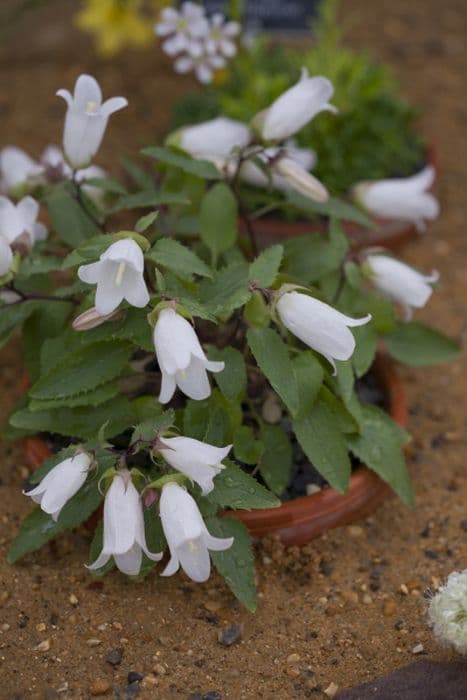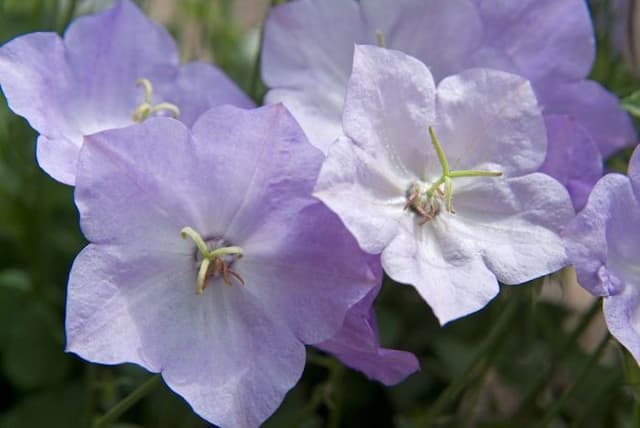Peach-leaved Bellflower Campanula persicifolia 'Azure Beauty'

ABOUT
The 'Azure Beauty' is a cultivar of the common plant known as Peach-leaved Bellflower. It is characterized by its beautiful bell-shaped flowers that have a striking azure or sky-blue color, which gives the plant its name. The petals are broad and somewhat fused, forming a cup or bell-like structure. The blooms gracefully hang from upright, slender stems, presenting a delicate and airy appearance. The foliage of 'Azure Beauty' consists of narrow leaves that resemble the leaves of a peach tree, hence the common name. These leaves are typically glossy and bright green, forming a low-growing basal rosette from which the flowering stems arise. The contrast between the lush greenery and the azure flowers creates a captivating visual display. Overall, the plant has a classic cottage garden look and is often valued for its flowering profusion and charming, fairy-tale aesthetic. It typically blooms in late spring to early summer and can add a touch of romance to any garden setting with its prolific and vivid blossoms.
About this plant
 Names
NamesFamily
Campanulaceae
Synonyms
Peach-Leaved Bellflower, Willow Bell, Fairy Bellflower, Peachleaf Bellflower
Common names
Campanula persicifolia 'Azure Beauty'
 Toxicity
ToxicityTo humans
The plant commonly known as Peach-leaved Bellflower is not known to be toxic to humans. There are no well-documented symptoms of poisoning from ingesting parts of this plant, as it is generally considered safe.
To pets
Peach-leaved Bellflower is also not known to be toxic to pets. It is not associated with any specific symptoms of poisoning in animals, indicating that it is generally regarded as safe for pets if they happen to ingest it. However, as with any plant, individual animals might have sensitivity or allergic reactions, and it's always best to prevent pets from eating plants not intended for their consumption.
 Characteristics
CharacteristicsLife cycle
Perennials
Foliage type
Deciduous
Color of leaves
Green
Flower color
Blue
Height
2-3 feet (60-90 cm)
Spread
1-2 feet (30-60 cm)
Plant type
Herb
Hardiness zones
3-7
Native area
Europe
Benefits
 General Benefits
General Benefits- Aesthetic Appeal: 'Azure Beauty' produces vibrant blue, bell-shaped flowers that add a splash of color to gardens and landscapes.
- Attracts Pollinators: The flowers of the Peach-leaved Bellflower attract bees, butterflies, and other beneficial insects, supporting biodiversity.
- Low Maintenance: Once established, it requires minimal care, making it ideal for gardeners of all skill levels.
- Cold Hardy: This plant is well-suited to cooler climates and can withstand frost, making it a robust choice for northern gardens.
- Drought Tolerant: Campanula persicifolia has a degree of drought tolerance, reducing the need for frequent watering during dry periods.
- Long Blooming Period: It has a relatively long flowering period, which spans from late spring to early summer, providing extended visual interest.
- Versatile Planting Options: Suitable for borders, rock gardens, and cottage gardens, it can adapt to various garden themes and styles.
- Perennial Growth: As a perennial, it returns year after year, giving a long-term presence in the garden.
- Improves Garden Structure: Its upright habit and height (up to 90 cm) can provide vertical interest in the garden design.
- Companion Planting: Works well when planted alongside roses and other perennials, helping to fill gaps and create fuller garden beds.
 Medical Properties
Medical Properties- This plant is not used for medical purposes.
 Air-purifying Qualities
Air-purifying QualitiesThis plant is not specifically known for air purifying qualities.
 Other Uses
Other Uses- Crafting natural dyes: The flowers of the Peach-leaved Bellflower can be used to create natural dyes for fabrics, offering hues of blue and purple.
- Decorative cake embellishments: Edible flowers from the Peach-leaved Bellflower can adorn cakes and desserts for an elegant, floral touch.
- Photography prop: The striking azure blooms make the Peach-leaved Bellflower a popular choice for garden photography and plant portraiture.
- Eco-friendly confetti: Dried petals of the Peach-leaved Bellflower can serve as biodegradable confetti for outdoor celebrations.
- Botanical illustration: Due to its beauty, the Peach-leaved Bellflower is often used as a subject in botanical art and illustration.
- Floral water infusions: Fresh blooms can be used to infuse water, giving it a subtle flavor and decorative appeal for special occasions.
- Garden ornamentation: When dried, the upright stems and seed heads add structural interest to floral arrangements and garden ornaments.
- Pressed flower art: The blooms press well, retaining color and shape, making them suitable for pressed flower crafts, such as bookmarks and cards.
- Fairy gardens: The delicate flower structure lends itself well to miniature fairy garden designs, providing an enchanting aesthetic.
- Teaching tool: The Peach-leaved Bellflower's distinct morphology is useful in educational settings to teach about plant structure and reproductive parts.
Interesting Facts
 Feng Shui
Feng ShuiThe Peach-leaved Bellflower is not used in Feng Shui practice.
 Zodiac Sign Compitability
Zodiac Sign CompitabilityThe Peach-leaved Bellflower is not used in astrology practice.
 Plant Symbolism
Plant Symbolism- Gratitude: The bell-shaped flowers of the Peach-leaved Bellflower symbolize thankfulness, often used in bouquets to express gratitude.
- Constancy: Its perennial nature makes it a representation of unwavering fidelity and steadfastness in relationships.
- Humility: Its nodding blooms can be seen as a nod to modesty and humility, making it a flower that supposedly signifies a down-to-earth persona.
- Vulnerability: The delicate structure of the flowers may represent vulnerability and the need to be cared for.
- Everlasting love: Often found in old gardens, they're connected to the idea of enduring love and the continuity of affection.
 Water
WaterThe Peach-leaved Bellflower should be watered deeply to encourage a strong root system, typically requiring about 1-2 gallons of water per week depending on the weather conditions. The soil should be kept evenly moist but not soggy. During the growing season in spring and summer, it's important to water more frequently, especially in the absence of rainfall. Aim to water the plant early in the morning to allow the foliage to dry out during the day, reducing the risk of fungal diseases. In the winter, reduce watering as the plant requires less moisture during dormancy.
 Light
LightPeach-leaved Bellflower thrives in full sun to partial shade. The ideal location would be a spot where it can receive at least four to six hours of sunlight a day. However, in hotter climates, it's beneficial to provide some afternoon shade to prevent scorching of the leaves.
 Temperature
TemperatureThe Peach-leaved Bellflower prefers moderate temperatures and can generally tolerate a range between 40 to 85 degrees Fahrenheit. It's hardy in USDA zones 3 through 8, surviving winter temperatures down to -40 degrees Fahrenheit, but it performs best when summer temperatures don't exceed the mid-80s on a regular basis.
 Pruning
PruningDeadheading the spent blooms of the Peach-leaved Bellflower encourages further flowering and prevents self-seeding if not desired. Prune back the foliage after flowering has finished to maintain a tidy appearance and promote healthy growth for the next season. Pruning is typically done in late summer or early fall once the plant has finished blooming.
 Cleaning
CleaningAs needed
 Soil
SoilThe Peach-leaved Bellflower 'Azure Beauty' thrives in well-draining, loamy soil with a pH range of 6.0 to 8.0. A perfect soil mix would consist of garden soil, compost, and perlite or sand to improve drainage. Organic matter like compost will provide necessary nutrients and promote healthy growth. Regularly check the soil pH to ensure it remains within the suitable range for optimal plant health.
 Repotting
RepottingPeach-leaved Bellflowers do not need frequent repotting and can generally be repotted every 2-3 years. It's best to repot these perennials in spring before the onset of the new growth cycle. Ensure they are placed into slightly larger containers with fresh, suitable soil mix as outlined above to accommodate their root development.
 Humidity & Misting
Humidity & MistingPeach-leaved Bellflower 'Azure Beauty' prefers moderate humidity levels but is quite adaptable to different humidity conditions. It does not require the high humidity levels that some more tropical plants might; normal room humidity is generally sufficient. Ventilation can help prevent any issues caused by humidity, such as fungal diseases.
 Suitable locations
Suitable locationsIndoor
Place in bright, indirect light and water when topsoil is dry.
Outdoor
Plant in partial shade or morning sun, in moist, well-drained soil.
Hardiness zone
3-8 USDA
 Life cycle
Life cycleCampanula persicifolia 'Azure Beauty', also known as Peach-leaved Bellflower 'Azure Beauty', begins its life cycle as a seed, which when sown in fertile, well-drained soil and with adequate sunlight, will germinate usually within 14 to 30 days. The seedling emerges and develops into a rosette of lanceolate leaves during its first year, establishing a strong root system. In its second year, the plant enters the vegetative stage, growing taller stems and more leaves, preparing for flowering. By early to midsummer, 'Azure Beauty' produces its characteristic bell-shaped, blue to violet flowers on long stalks, which can attract pollinators such as bees and butterflies to the garden. Following pollination, the plant sets seed, which can be collected for propagation or allowed to self-sow in the garden. After blooming, which can last several weeks, the plant gradually enters dormancy in late fall or winter and may die back, completing its perennial cycle, although the plant itself can live for several years.
 Propogation
PropogationPropogation time
Spring to early summer
Propogation: The most popular method of propagating the Peach-leaved Bellflower 'Azure Beauty' involves division, which is ideally carried out in the early spring as new growth begins. To propagate by division, gently lift the clump of the bellflower from the ground using a spade to ensure a good amount of roots are intact. The clump should then be divided into smaller sections, each with a piece of the crown and several root shoots. The divisions can then be replanted at the same depth they were growing at originally, spacing them about 12 to 15 inches (30 to 38 centimeters) apart to allow ample room for growth. After planting, it's essential to water the divisions thoroughly to help establish the new plants in their location. This method encourages healthy growth and can rejuvenate older plants that may have become woody or have a dead center.









